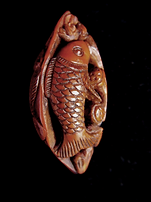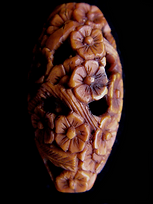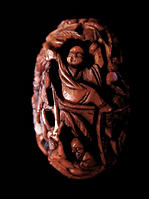
Roland Himmler & Guat Cheng Poh

Chinese Seed Carvings
Galleries
Wishes in Miniature
It is said that carved olives or carved rosaries have no religious meaning. But if you compare the designs you will find / see them everywhere in the monastery. The reason: Chinese believe that heaven is organized like government on earth with a president, ministers etc. Everyone with his portfolio. Unusual: the position holder can be a human being or an animal. As a result: a huge pantheon of illustrious figures.
Boats have always been a popular design group for many centuries (Ming and Quing dynasty). Some of them can be found in world famous museums like the National Palace Museum or at Sotheby's auctions in London (1998).
Very different animals are carved on olives. Rarer types are for instance: elephants, crocodiles, turtles and snakes. The zodiacs signs also show animals: In order, they are the Rat, Ox, Tiger, Rabbit, Dragon, Snake, Horse, Goat, Monkey, Rooster, Dog, and Pig.
Body care was difficult in the old days because of lack of options and possibilities, therefore the small perfume bottles, be carried in the sleeve cover, were welcome and quite popular.
Dieties in general represent wishes to be full-filled like "long life", wealth, success in business, getting a son or protection against evil spirits and similar harming ghosts.
This group has designs unknown to us or not mentioned in literature. It might be user specific design/wishes which might cover every possibility combination of a given design.
These objects are much smaller than rosaries. As a design they may have 8 immortals (8 persons) or eighteen Luohans (nine pearls / two faces per pearl).
For Indians a rosary has sixteen pearls, for Chinese eighteen pearls (according to the number of Arhats/Luohan or a total 108 pearls). For a monk a rosary has un-carved pearls.
In the past carvers were carving at the emperor court. today a total village may live on carvings like: Yongquing, Lanfang or Sanher. Today most important is Suzhou near Shanghai. Main customers of these carvers are from Japan and South Korea.
There is nearly no seed which is not carved by Chinese carvers. By far the most carved seeds are the Chinese olives (canarium pimela), walnuts (juglans regia and manshurica), peach, apricot, cherry and different round ones especially used for rosaries (mountain-xyz).
Here designs which only have been found by us exceptionally or mentioned only exceptionally in literature, are shown.
In principle flowers are carved which have a specific meaning, but as well plants representing longevity (ever-green like bamboos or pine trees) are very popular.
Usually this design type shows trees and a building on one side and on the other side a Luohan or immortal. The meaning of the carving is more defined by the Luohan or immortal and their meaning.
In contrary to the westerner where the twelve zodiac signs. lasting a month each and are evenly distributed throughout a year, the Chinese zodiac signs have twelve animals as well but each of them is defining one year.
Normally faces of the eight immortals or eighteen Luohans are carved. To fill a bracelet of nine pearls, two or three faces per olive are carved.
These prices are randomly taken to get an idea about the the prices for carved Chinese seeds (first price is previous year second price tag is current year). More prices can be found on Chinese hediao websites (nut carving, known as Hediao in Chinese).
Main customers and collectors are targeted in Korea, Taiwan and Japan.
Price: 100 US $
Roy Hu’s Asian Art Taipei
Pavillions in combination with cranes strongly suggests the place to be the "Island of the Immortals.
Not far from Shanghai is Zhousan village, where approximately 10'000 people make their living from carving olive pits. A sign that spells out "Olive Village" in Chinese welcomes visitors to this village in the western suburbs of Suzhou, a city about 50 miles west of Shanghai in Eastern China.
This collection should show you the variety of design.
Number of items in the collection: 1020 (olives in rosaries or bracelets not counted).
Not far from Shanghai is Zhousan village, where approximately 10'000 people make their living from carving olive pits. A sign that spells out "Olive Village" in Chinese welcomes visitors to this village in the western suburbs of Suzhou, a city about 50 miles west of Shanghai in Eastern China.
They in general have six to nine pearls. The design is the same like rosaries.
Number of items in the collection: 36
As you can see not only olives are used for rosaries. The more round pieces are called "mountain peaches" (whatever it means).
Number of items in the collection: 38
Unfortunately they are no longer carved as they hardly cannot be found for sale anymore. Possibly the carving of walnuts is too labour intensive.
Number of items in the collection: 105
The design normally is adopted by the very strong structure of the seed. This might be the reason why you can only find them exceptionally for sale.
Number of items in the collection: 30
These items are double in the collection. They are either for exchange or sale.
Number of items in the collection: approx. 210






















